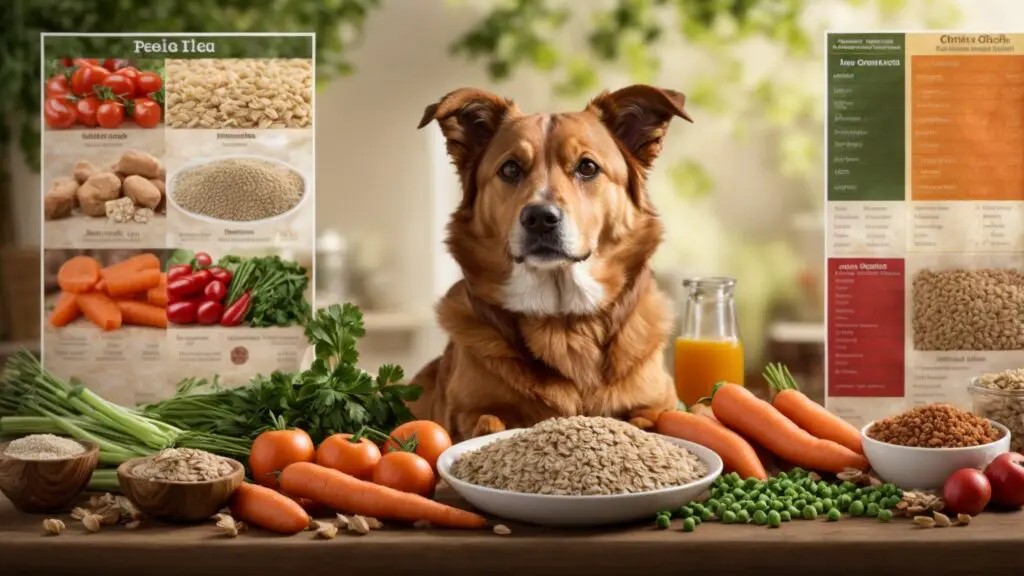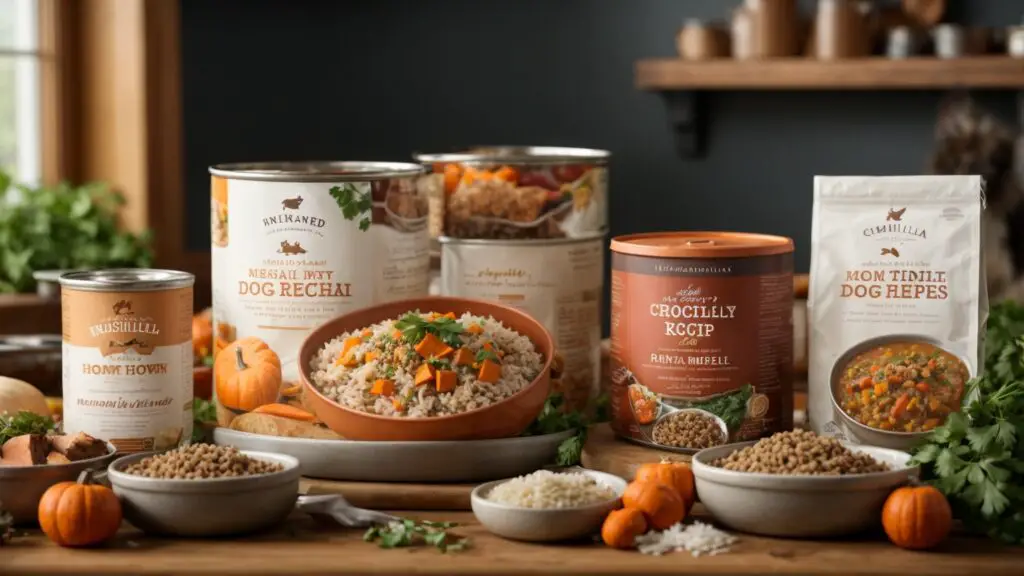Estimated reading time: 16 minutes
Introduction
Selecting the right dog food brands is not just about satisfying your pet’s appetite. It’s a crucial decision that impacts their overall health and wellbeing. As pet owners, we understand dogs have unique dietary needs and preferences. Whether it’s a playful puppy or an adult dog with specific health requirements, the choice of dog food plays a pivotal role in maintaining their health, energy levels, and longevity. The market is flooded with various brands, each claiming to be the best. However, deciphering the truth from marketing hype requires understanding what constitutes good dog food.
Finding the perfect dog food brand for your furry friend starts with understanding the essential nutrients they need. Dogs, like humans, require a balanced diet consisting of proteins, fats, carbohydrates, vitamins, and minerals. However, the proportion and source of these nutrients can vary significantly between dog food brands. Quality brands often feature high-quality protein sources healthy fats, and are free from unnecessary fillers and artificial additives. Recognizing the ingredients that should (and shouldn’t) be in your dog’s food is the first step towards choosing a brand that supports their health and happiness.
In this journey, it’s vital to consider specific factors such as your dog’s age, breed, activity level, and any health issues they might have. For instance, active dogs may require food with higher energy content, while dogs with sensitive stomachs need easily digestible ingredients. In addition, emerging trends in dog nutrition, like grain-free or limited-ingredient diets, cater to specific dietary needs and preferences. Understanding these nuances will guide you in selecting a dog food brand that meets the basic nutritional requirements and caters to your dog’s unique health and lifestyle needs.
Key Takeaways
- Balanced Nutrition: The right dog food brand provides a balanced mix of proteins, fats, carbohydrates, vitamins, and minerals.
- Quality Ingredients: High-quality dog food brands feature premium ingredients and avoid unnecessary fillers.
- Health and Longevity: Quality dog food can significantly impact your pet’s health and longevity.
- Specialized Diets: Top dog food brands cater to specific dietary needs like grain-free or limited-ingredient options.
- Brand Research: Thorough research and understanding dog food brands are essential for making an informed choice.
- Personalized Selection: The ideal dog food brand varies based on individual dog needs, such as age, breed, and health conditions.
- Emerging Trends: Keeping up with trends in dog nutrition can lead to better food choices for your pet.
- Cost-Effectiveness: Balancing quality and cost is critical in choosing the right dog food brand.
- Veterinarian Recommendation: Consultation with a vet can guide you in selecting the most suitable dog food brand.
Understanding Pet Nutrition and Dog Food Ingredients
Importance of Balanced Nutrition in Dog Food
Understanding the importance of balanced nutrition in dog food is crucial for the health and well-being of your pet. A diet rich in essential nutrients like protein, carbohydrates, fats, vitamins, and minerals ensures your dog remains healthy, active, and happy. With many options, selecting the right dog food brand becomes a significant responsibility for pet owners.
Case Study: One compelling case study involves a senior dog named Max, who experienced a dramatic health transformation after switching to a high-quality dog food brand. Previously sedentary and overweight, Max became more energetic and healthier with a diet tailored to his age and specific needs.
Deciphering Dog Food Labels – What to Look For
Deciphering dog food labels is vital for understanding what you’re feeding your pet. Look for brands that list real meat, vegetables, and whole grains as primary ingredients. Avoid those with excessive fillers, artificial colors, or preservatives.
List: Key Ingredients in Premium Dog Food
- The primary protein source is real meat (chicken, beef, fish).
- Whole grains like brown rice are carbohydrates.
- Healthy fats like fish oil are good for skin and coat health.
- Fruits and vegetables for essential vitamins and minerals.
- We have added vitamins and minerals for complete nutritional balance.
Common Misconceptions About Dog Food Ingredients
Common misconceptions about dog food ingredients include believing that grains harm all dogs or that more protein means better quality. Each dog’s needs can vary, so understanding these nuances is important.
The Role of Additives and Preservatives in Dog Food
Understanding the role of additives and preservatives in dog food is vital. While some preservatives are necessary for shelf stability, look for natural options like vitamin C or E and avoid artificial and potentially harmful chemicals.
Making informed choices about dog food ingredients involves understanding your dog’s needs, reading labels carefully, and choosing a brand that uses high-quality, beneficial components. This ensures your dog gets the nutrition they need for a long, healthy life.

Top Dog Food Brands Reviewed
Evaluating Popular Dog Food Brands
When it comes to your pet’s health, choosing the right dog food brand is paramount. With numerous options in the market, from kibble to wet dog food, it’s essential to evaluate these brands based on their ingredients, health benefits, and price to find the best fit for your furry friend.
List: Overview of Top-Rated Dog Food Brands
- Purina Pro Plan
- Taste of the Wild
- Purina One
Purina Pro Plan Review – Ingredients, Health Benefits, and Price
Purina Pro Plan is renowned for its high-quality ingredients, including real meat as the primary source. It offers specific formulas for different life stages and dietary needs, balancing nutrition and cost-effectiveness.
Taste of the Wild Review – Ingredients, Health Benefits, and Price
Taste of the Wild focuses on grain-free formulas, providing a diet closer to what dogs eat in the wild. Its recipes, rich in meat and fish proteins, cater to dogs with sensitivities and those requiring a high-protein diet.
Purina One Review – Ingredients, Health Benefits, and Price
Purina One offers a blend of crunchy kibble and meaty morsels, focusing on real meat, vegetables, and whole grains. It’s a budget-friendly option that doesn’t compromise nutritional value, making it popular among pet owners.
A veterinarian quoted, “Quality dog food brands like Purina Pro Plan and Taste of the Wild not only fulfill the basic nutritional requirements but also address specific health concerns, promoting overall wellbeing.”
While Purina Pro Plan excels in specialized nutrition, Taste of the Wild stands out for its grain-free options, and Purina One offers excellent value for money. The choice depends on your dog’s specific needs and your budget.
Health Benefits of Quality Dog Food
The Impact of Dog Food Quality on Health
Choosing quality dog food is crucial for your pet’s health and well-being. Premium dog food brands offer balanced nutrition that can significantly impact a dog’s physical condition, energy levels, and lifespan. Understanding these benefits helps make an informed decision when selecting a dog food brand.
List: Major Health Benefits of Choosing Quality Dog Food
- Enhanced Immune System: High-quality ingredients strengthen your dog’s immunity.
- Improved Digestive Health: Proper nutrition aids in better digestion.
- Healthy Skin and Coat: Essential nutrients promote a shiny coat and healthy skin.
- Optimal Weight Management: Balanced diets help maintain a healthy body weight.
- Joint and Bone Health: Key nutrients support strong bones and joints.
- Increased Energy and Vitality: Proper nutrition leads to higher energy levels.
- Longevity: Quality dog food can contribute to a longer, healthier life.
Nutritional Balance and Its Effects on Canine Health
A healthy balance is critical in dog food. The correct proportions of protein, fats, and carbohydrates are essential for maintaining your dog’s health, particularly in different life stages and specific breeds.
The Link Between Diet and Longevity in Dogs
The link between a dog’s diet and longevity is well-documented. Quality dog food that meets all nutritional requirements can significantly extend a dog’s lifespan, reducing the risk of diseases and health issues.
A veterinary nutritionist stated, “The diet we choose for our dogs can directly affect their overall health. Quality dog food with the right nutrients can prevent numerous health issues and improve quality of life.”
Investing in quality dog food is investing in your pet’s future. It’s not just about fulfilling their basic dietary needs but also about enhancing their quality of life and ensuring they remain healthy, active, and with us for as long as possible.

Cost vs. Quality: Finding the Best Value in Dog Food Brands
Balancing Cost and Quality in Dog Food Choices
Finding the best value in dog food brands requires balancing cost with quality. It’s crucial to understand that cheaper options might not always be the most beneficial for your pet’s health, and the most expensive options are not always the best regarding nutritional value.
List: Factors to Consider When Evaluating Dog Food Value
- Ingredient Quality: Higher quality ingredients usually mean better nutrition.
- Brand Reputation: Established brands often offer consistent quality.
- Nutritional Adequacy: Ensuring the food meets your dog’s dietary needs.
- Special Dietary Needs: Consider any special health requirements of your pet.
- Price per Serving: Comparing the cost relative to the serving size.
How to Determine the True Cost of Dog Food
The actual cost of dog food goes beyond the price tag. It involves considering long-term health benefits, feeding frequency, and the amount required to maintain a healthy diet for your pet.
Table: Comparison of Cost and Nutritional Value Across Different Brands
| Brand | Price Range | Key Features | Suitable For |
|---|---|---|---|
| Purina Pro Plan | Moderate | High-quality ingredients, complete nutrition | All life stages |
| Hill’s Science Diet | Higher | Specialized for sensitive stomachs | Adult dogs sensitive |
| Blue Buffalo Life Protection Formula | Budget-friendly | Good ingredient quality, real meat as the first ingredient | All life stages |
Tips for Budget-Friendly, High-Quality Dog Food Choices
When feeding your pet, making budget-friendly choices without compromising quality is crucial. One effective strategy is Bulk Purchasing. Buying dog food in larger quantities can often save money in the long run, as many brands offer discounts on bulk purchases. This approach primarily benefits households with multiple pets or larger breeds with more significant dietary needs.
Another tip is to keep an eye out for Special Offers and Discounts. Many pet stores and online retailers have regular sales, promotions, and loyalty programs. Taking advantage of these deals can significantly reduce the cost of high-quality dog food.
It is essential to prioritize Quality Over Quantity. Investing in better quality food might seem more expensive upfront, but it can be more cost-effective in the long run. High-quality dog food is often more nutritionally dense, meaning you’ll need to feed less than cheaper, lower-quality options. This provides better nutrition for your pet and means the food will last longer, leading to savings over time. By considering these tips, pet owners can find high-quality dog food options that are also budget-friendly.
Finding the best value in dog food brands is about understanding your pet’s nutritional needs and balancing cost and quality. It’s about making an informed choice that ensures the health and happiness of your furry friend without breaking the bank.
Special Dietary Needs and Dog Food Options
Addressing Specific Dietary Requirements in Dogs
Catering to the specific dietary requirements of dogs is crucial for their health and well-being. With various nutritional needs based on breed, age, and health conditions, finding the right dog food is vital to pet care. This section explores standard dietary requirements and the corresponding food options available.
List: Common Dietary Needs and Corresponding Food Options
- Grain-Free Diets for dogs with grain allergies or sensitivities.
- High-protein diets for active and working dogs.
- They limit ingredient diets for dogs with food intolerances.
- Weight Management Formulas for overweight dogs.
- Senior Dog Foods is specifically formulated for older dogs.
- Puppy Formulas are designed for the nutritional needs of growing puppies.
Grain-Free, Organic, and Natural Dog Food Choices
Exploring grain-free, organic, and natural dog food choices is essential for pet owners with specific dietary restrictions. These options often provide alternative sources of carbohydrates like sweet potatoes and are free from artificial additives.
Case Study: A dog with chronic digestive issues showed remarkable improvement on a grain-free diet, highlighting the importance of choosing a diet suited to individual health needs.
Managing Allergies and Sensitivities Through Diet
Effective management of allergies and sensitivities is possible through diet. Choosing hypoallergenic or limited-ingredient dog foods can significantly reduce allergic reactions and improve overall health.
Senior Dog Diet Considerations
Senior dogs have different nutritional requirements. Foods designed for older dogs typically contain lower calories and higher fiber content, along with supplements like glucosamine for joint health.
Personalizing dog food choices based on a dog’s individual health needs is critical. Whether it’s grain-free options for allergies or specific formulas for puppies and seniors, the right food can significantly affect your pet’s health and quality of life.

The Future of Dog Food: Trends and Innovations
Emerging Trends in the Dog Food Industry
The dog food industry is continuously evolving, with new trends and innovations shaping the future of pet nutrition. As pet owners become more informed and conscientious, the demand for higher quality, sustainable, and specialized dog food options is growing.
Table: Innovations in Dog Food Formulation and Production
| Innovation Category | Description |
|---|---|
| Tailored Nutrition | Customized diets based on genetic makeup, lifestyle, and health conditions. |
| Sustainable Practices | Eco-friendly packaging and sourcing of ingredients. |
| Technology Integration | Use of apps and smart devices for personalized feeding. |
| Alternative Proteins | Introduction of insect-based and lab-grown meat options. |
| Enhanced Health Benefits | Incorporation of supplements like probiotics and omega-3 fatty acids. |
Sustainable and Eco-Friendly Dog Food Options
Sustainable and eco-friendly options are increasingly popular in the dog food market. Brands focus on reducing their carbon footprint through sustainable sourcing and environmentally friendly packaging.
An industry expert stated, “The future of dog food lies in innovation, sustainability, and personalized nutrition. We’re seeing a shift towards eco-friendly practices and technology-driven solutions.”
The future of dog food is exciting and dynamic, focusing on sustainability, technology, and tailored nutrition. As the industry evolves, we can expect to see more innovative products that cater to dogs’ diverse needs while prioritizing environmental responsibility.
Recap of Key Insights from the Post
In this comprehensive exploration of dog food brands, we’ve delved into various aspects crucial to your pet’s health and nutrition. From understanding the importance of quality ingredients and balanced diets to navigating the vast array of products available, we aim to provide pet owners with the knowledge needed to make informed decisions.
List: Summary of Crucial Points Covered in Each Section
- Importance of Nutritional Balance: Choosing the right ingredients for optimal health.
- Review of Top Dog Food Brands: Evaluating popular brands for quality and value.
- Health Benefits of Quality Dog Food: How premium food impacts overall wellbeing.
- Balancing Cost and Quality: Finding the best value in dog food.
- Special Dietary Needs: Tailoring food choices to your dog’s specific requirements.
- Emerging Trends and Innovations: The future direction of dog food industry.
Best Practices in Choosing Dog Food Brands
When selecting dog food brands, it’s essential to consider factors like ingredient quality, nutritional balance, and your pet’s specific needs. Researching and understanding the brand’s reputation and ingredient sourcing can significantly influence your choice.
The Importance of Continual Learning and Adaptation
Continual learning and adaptation are vital in the ever-evolving world of pet nutrition. Keeping abreast of the latest research and trends helps ensure that your pet gets the best possible diet.
Looking Ahead: The Future of Dog Nutrition
The future of dog nutrition will likely see even more personalized and sustainable options, with technological advancements and a greater emphasis on eco-friendly practices.
In conclusion, choosing the best dog food brands for your pet means balancing many factors, including nutritional needs, budget, and the latest trends in pet care. It’s a journey that requires careful consideration but ultimately leads to the well-being and happiness of your beloved companion.
Frequently Asked Questions
Finding the best dry dog food depends on your dog’s needs and preferences. However, some of the top-rated brands for 2023 include Purina, Kibble, Puppy and More. These brands offer various flavor options, high-quality ingredients, and foods suitable for all life stages, from puppy to adult.
Grain-free dog food can be an excellent choice for dogs with food sensitivities. This diet eliminates grains like wheat, corn, and rice, common allergens for some dogs. However, it’s always best to consult your vet before changing your dog’s diet.
The most important thing when choosing puppy food is to ensure that it is specifically designed to meet the nutritional needs of puppies. Many brands, including Purina and Kibble, offer excellent puppy foods. These focus on higher protein content for growing bodies and often include a smaller kibble size to accommodate a puppy’s more petite mouth.
Both dry and wet dog food have their benefits. Dry dog food is typically more cost-effective, can help clean your dog’s teeth as they eat, and is more convenient to store. On the other hand, wet dog food can be more appealing to some dogs due to its texture and smell, and it offers a source of hydration.
Small breed dry dog food usually contains smaller kibble sizes for tiny mouths and a denser calorie content due to a smaller dog’s higher energy needs. Foods specifically formulated for small breeds also often contain nutrients targeted at their specific health needs.
If your dog has a sensitive stomach, look for dry dog foods with a simple ingredient list with high-quality proteins and digestible carbohydrates. Some brands offer unique formulas specifically designed for dogs with sensitive stomachs. Always consult with your vet in case your dog needs a specific diet.
Specific dry dog foods are formulated with skin health in mind. These foods contain higher levels of essential fatty acids, like Omega-3 and Omega-6, which can promote healthy skin. Chicken recipes, dry dog food, or salmon as a protein source can provide additional benefits for sensitive skin.
Vegetable-flavored dog kibble not only adds variety to your dog’s diet but can also provide essential nutrients. Vegetables can provide vitamins, minerals, and fiber, aiding digestion. Be sure to choose quality brands that use natural vegetables as ingredients, as these will offer the most significant nutritional benefit.
Popular high-quality protein sources include chicken, beef, and fish like salmon. Grain-free dog foods often rely heavily on these animal-based protein sources. Some pet food companies are also concocting recipes that include novel proteins like duck or venison. Ultimately, the best source of protein for your dog depends on their individual dietary needs and food preferences.
When transitioning your dog to a new food, it’s recommended to do it slowly over a week or longer. Start by mixing a small amount of the new food with the old, and gradually increase the new food while decreasing the old. This can help prevent digestive upset and help your dog acclimate to fresh food.
Conclusion
In conclusion, this comprehensive exploration into the world of dog food brands has offered a deep dive into the various elements essential for ensuring the health and well-being of our canine companions. From understanding the crucial balance of nutrients in dog food to evaluating the top brands on the market, we’ve covered various topics to equip pet owners with the necessary knowledge for making informed decisions. We’ve looked at the importance of catering to specific dietary needs, balancing cost with quality, and staying updated with the latest trends and innovations in dog nutrition.
The key takeaway is that choosing the right dog food is a multifaceted decision beyond flavor or price. It’s about understanding and meeting the unique nutritional needs of your pet, considering their life stage, health conditions, and lifestyle. The right dog food can significantly enhance your dog’s health, vitality, and longevity, making your choice an essential part of your pet’s overall care.
As we move forward, the dog food industry will continue to evolve, bringing forward more personalized, sustainable, and technologically integrated feeding solutions. This means an ongoing commitment to learning and adapting to new information and trends for pet owners. By staying informed and mindful of these developments, we can ensure that our furry friends receive the best possible nutrition, paving the way for a healthier, happier life together.

James Dunnington leads the James Dunnington Collection, featuring five unique blogs: a practical Pet Care Guide, an enlightening Ancient History Blog, a resourceful Home Improvement Guide, a cutting-edge Tech Innovation Guide, and a strategic Online Money Making platform. Each site delivers valuable insights designed to empower and inform. For updates and more tips, visit our Contact Us page to sign up for our newsletter, ensuring you never miss out on the latest content from any of these dynamic fields.